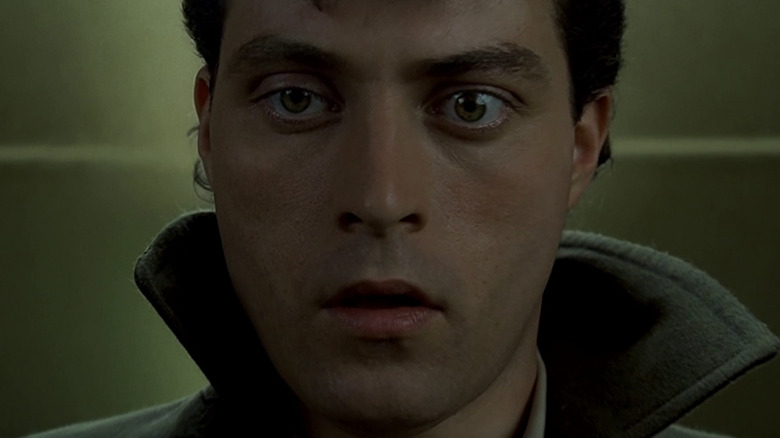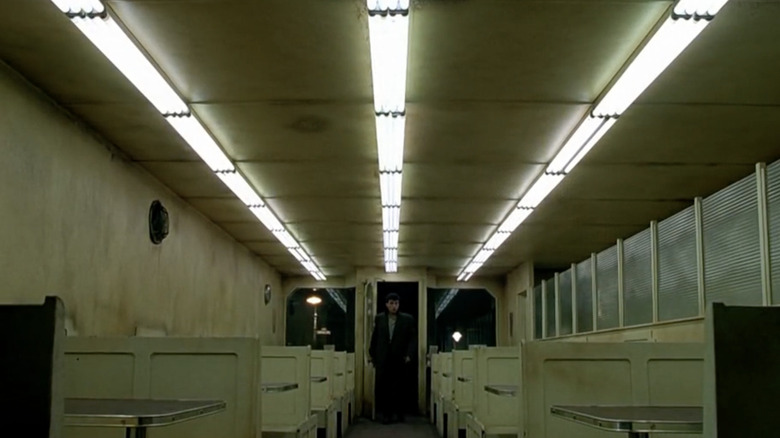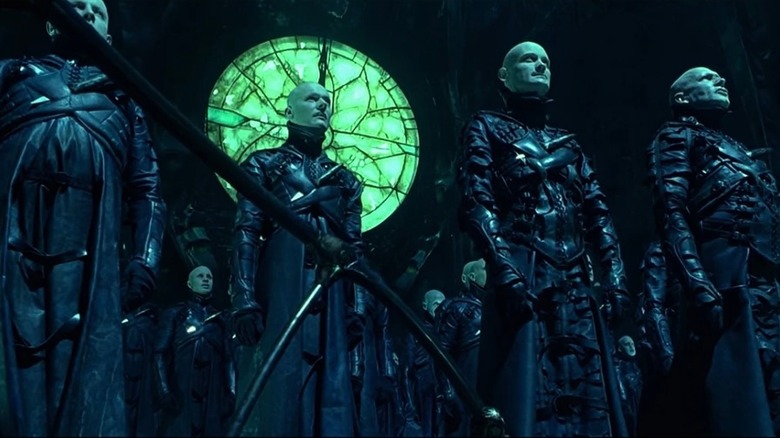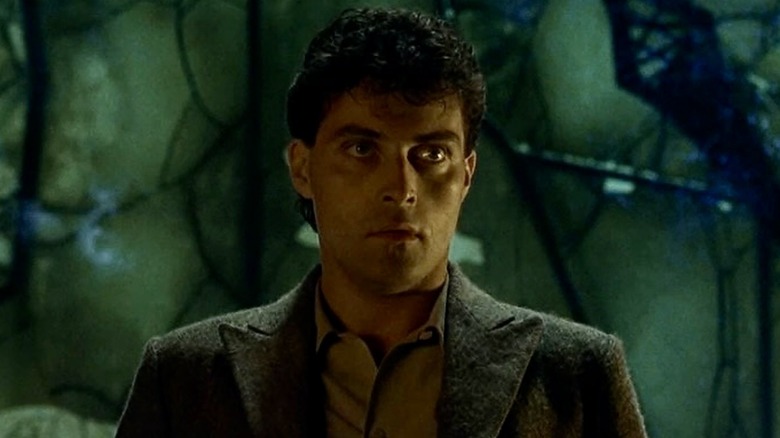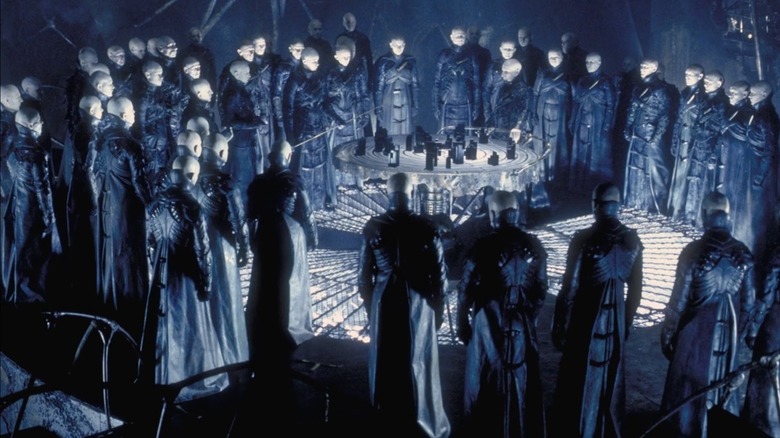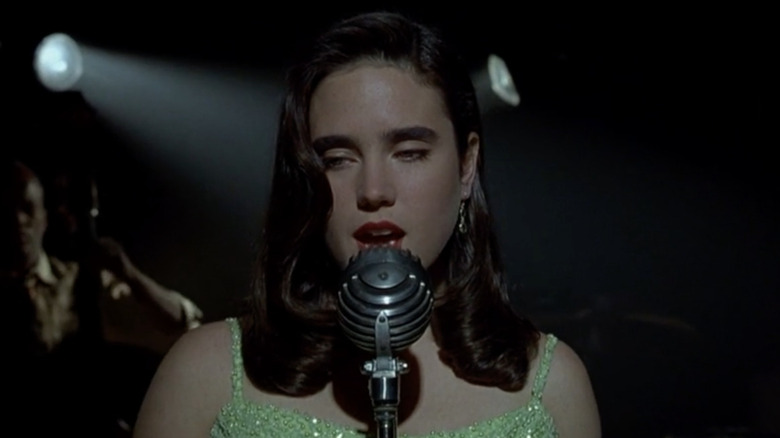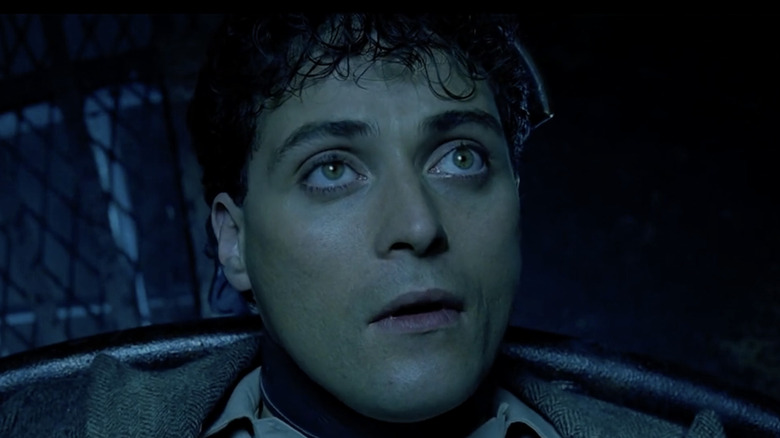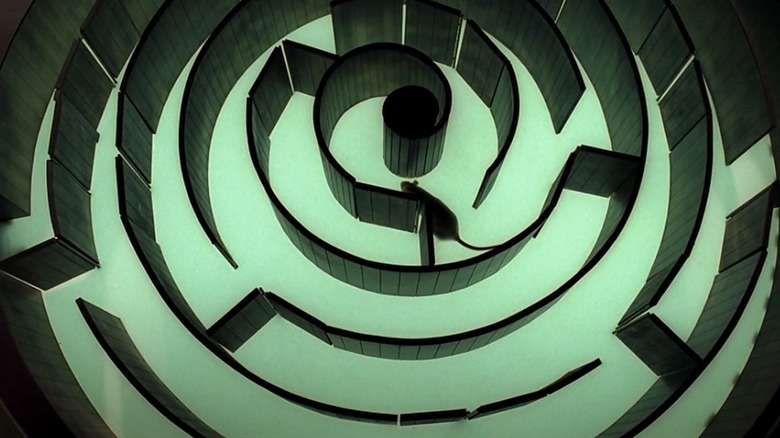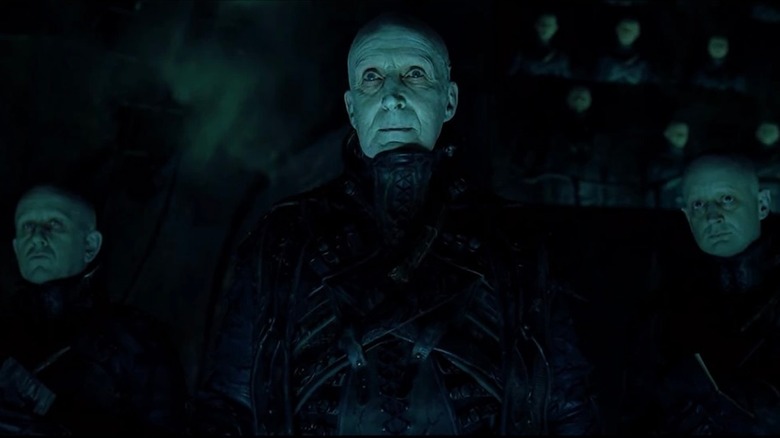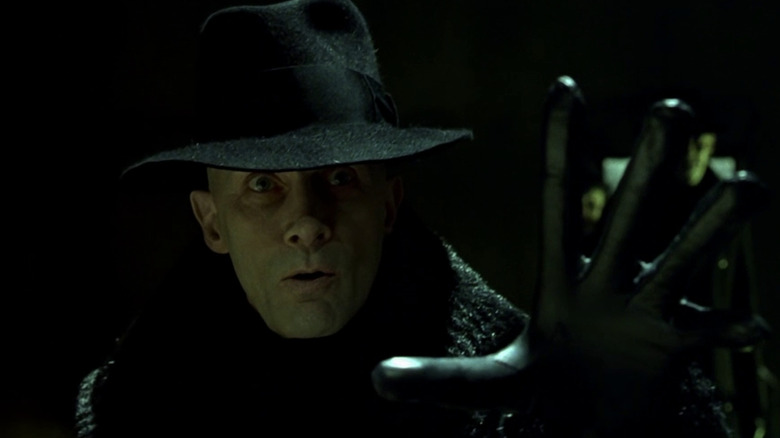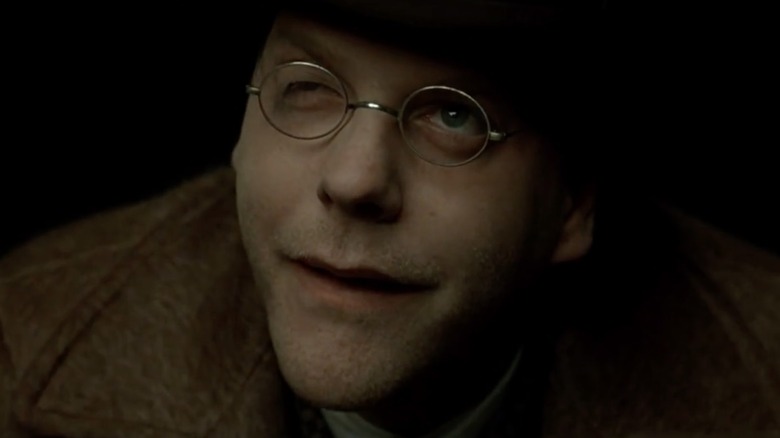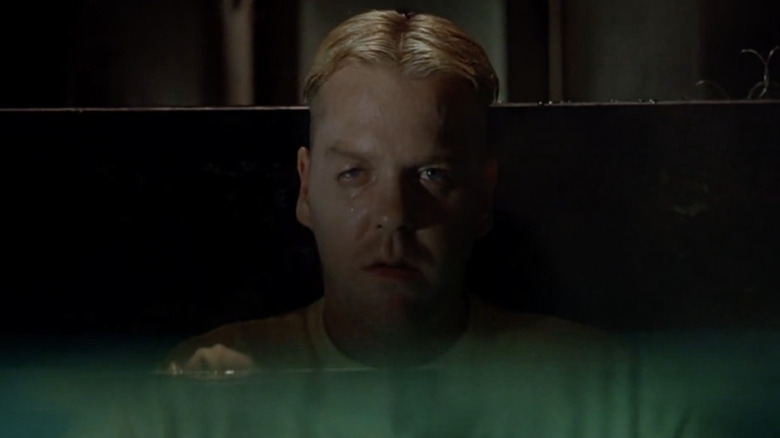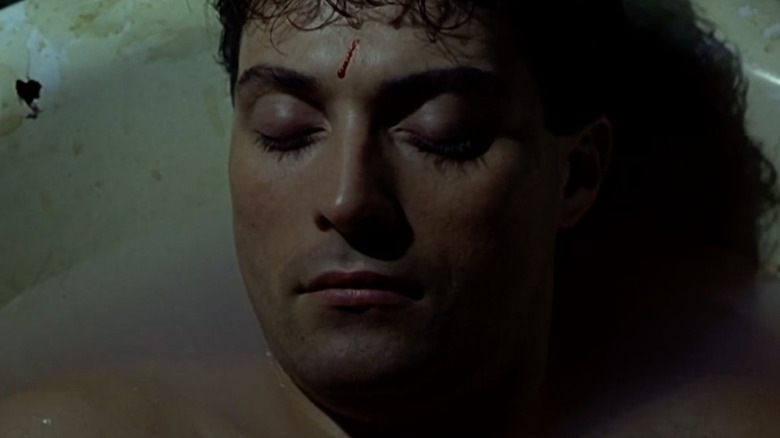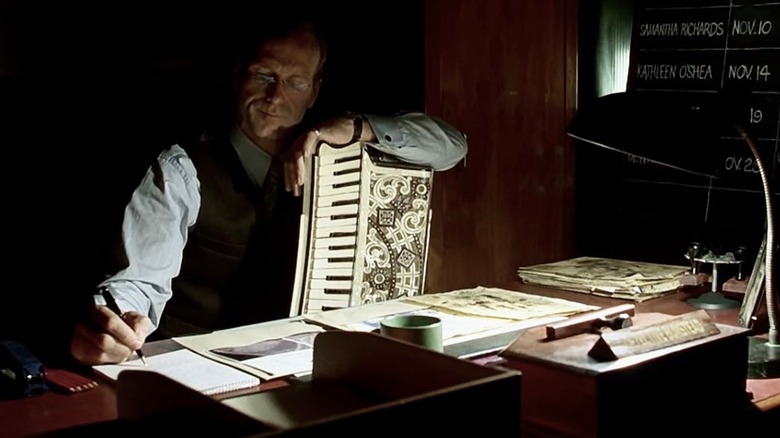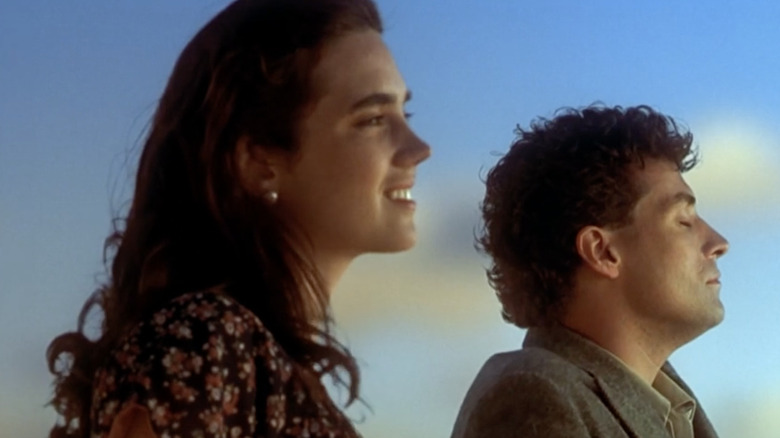The Untold Truth Of Dark City
Director Alex Proyas' 1998 feature "Dark City" builds upon the menacing urban landscape that he created for his 1994 comic book adaptation of "The Crow." "Dark City" is a neo-noir science fiction film that is both mind-bending and genre-blending, which includes elements of gothic horror to create a stylized and atmospheric mise en scène. The film opens with a man (Rufus Sewell) awakening in a bathtub. He is disoriented and can't recall who he is. The phone rings and when he answers, Dr. Schreber (Kiefer Sutherland) tells him he is part of an experiment gone wrong and that he must leave because nefarious men are pursuing him.
He soon learns his name is John Murdoch and that not only must he evade these mysterious pursuers, but he is also wanted for a murder he doesn't remember committing. The amnesiac Murdoch searches vague flashes of memory and this strange city for clues of who he is and what happened to the woman he supposedly killed. Murdoch soon comes to understand that he can't trust his memories or even the reality of the world in which he lives.
"Dark City" was released just a year before "The Matrix," and while both films deal in the existential question of reality in sci-fi settings, the latter became a cultural touchstone and box office giant, while "Dark City" flopped at the box office and has taken on a cult status instead. Beloved by critics at the time and still loved by fans who swear by Proyas' vision, "Dark City" is dense with ideas, symbols, and meanings and the untold truth of this cult film is just as layered.
Warning: spoilers below!
Dark City was filmed on sets to heighten its stylized look
The artistic vision for the anachronistic and bizarre world of "Dark City" came from the mind of writer-director Alex Proyas, but this vision was brought to life with the help of art directors Richard Hobbs and Michelle McGahey, production designers George Liddle and Patrick Tatopoulos, and costume designer Liz Keogh. The stunning results give the film a singular look.
The only scene shot on location during the entire production of "Dark City" is the ocean one at the end of the movie. Everything else was filmed on sets constructed in Sydney, Australia. In the director's commentary that accompanies the Blu-ray DVD, Proyas explained how this allowed him to tweak the angles of walls and ceilings to twist the set, adding to the disorientation of the audience (per Film School Rejects).
Production designer Patrick Tatopoulos discussed the unsettling feeling of the sets in an interview with the magazine Cinefantastique: "It's a city built of pieces of cities. A corner from one place, another from someplace else. So, you don't really know where you are. A piece will look like a street in London, but a portion of the architecture looks like New York" (per Giant Freakin Robot).
"Dark City" is often compared to the sci-fi juggernaut "The Matrix," as both films explore similar themes of identity and false realities, although the more commercially successful "Matrix" film came out a year after Proyas'. That's not all these two films share, as the Wachowskis actually shot some scenes of "The Matrix — like the opening roof-top chase — on sets that were created for "Dark City" (per What Culture).
Dark City barely earned back its production budget despite getting praise from critics
Despite its arresting visuals and original story, "Dark City" was a bust at the box office and barely recouped its production budget (per The Numbers). Still, films that lack broad appeal are often ripe for a cult following, which "Dark City" found through its home video release. While "Dark City" may not have found its audience during its original run, it did land with the critics: The film has favorable scores on Metacritic and a fresh rating on Rotten Tomatoes.
Acclaimed film critic Roger Ebert loved the film, giving it a rare 4-star review and calling it a "great visionary achievement" that is "a triumph of art direction, set design, cinematography, special effects — and imagination." Peter Stack at The San Francisco Chronicle called the film "hypnotic, haunting and, to be sure, dark. It is among the most memorable cinematic ventures in recent years."
Despite the effusive and universal praise of the film's aesthetic sensibilities, some critics like Walter Addiego of The San Francisco Examiner suggested that the film was guilty of preferring style over substance. Overall, "Dark City" garnered positive critical reviews and even better audience responses on Rotten Tomatoes, as the film has continued to find a new life and audience years after its theatrical run.
Roger Ebert and the crew both recorded a feature-length commentary for the DVD
Roger Ebert was such a passionate proponent of "Dark City" that this is only one of six films that he recorded feature-length commentary for, and he did so for both the New Line Platinum Series and the director's cut Blu-ray DVD (per ScreenCrush). Ebert also did a frame-by-frame analysis of the film with an audience at the Hawaii Film Festival, writing in a 2005 review, "I believe more than ever that 'Dark City' is one of the great modern films." Ebert is effusive in his praise of Proyas' film, acknowledging how deftly it examines the ways that the construction of our identity is tied directly to our memories. Ebert is even generous with the Strangers, finding compassion for their inability to understand the human soul or to experience the greatest of mysteries — love.
The New Line Platinum DVD also includes a crew commentary, featuring director Alex Proyas, screenwriters Lem Dobbs and David S. Goyer, cinematographer Dariusz Wolski, and production designer Patrick Tatopoulos. This commentary goes into the creation of the film, as well as the meaning behind these choices, like the use of built sets, lighting decisions, filming with long lenses. Proyas goes further into these observations and the differences between the theatrical cut and the director's cut in his commentary for the director's cut DVD (per Film School Rejects).
Dark City can be viewed as a parable about fascism
German expressionism — a post-WWI style of deep shadows, and twisted and skewed angles (per BFI) — clearly influenced "Dark City," which bears comparisons to Fritz Lang's 1927 classic "Metropolis" both visually and thematically. Lang's iconic silent science-fiction film is the epitome of German expressionism and was a clear warning about the growing fascism in Germany after WWI, as the country suffered economic devastation and division after the war. "Metropolis" focuses on this in its representation of class and the ways the rich dominate the poor.
While "Metropolis" speaks to the rise of fascism in the interwar years, "Dark City" can be read through a WWII lens. The Strangers elicit more subtle comparisons to Nazis and their imprisonment of Jewish citizens and other minorities in Germany during Hitler's reign of terror. The Strangers' unethical experiments on the humans, as well as Dr. Schreber's collusion and collaboration with them, conjures up thoughts of the Nazis' horrific medical experiments done on prisoners in concentration camps (per The United States Holocaust Memorial Museum).
Additionally, the Strangers' visually monolithic look — their black coats and fedoras above ground, and their leather fetish-wear underground — create associations with organized fascist groups like the Nazis, as Roger Ebert suggested in his film commentary for the DVD.
Dark City questioned the nature of reality and identity
Questioning reality was a popular theme in the '90s, with movies like "The Truman Show," "The Matrix," and "Dark City" exploring worlds that were manipulations of reality (via Luddite Robot). In the case of "Dark City," John Murdoch learns that he lives in a city of perpetual darkness, which is controlled by The Strangers, aliens with a shared consciousness, who can shape reality with their minds using "tuning."
The Strangers control this world by mixing and matching the memories of humans in an elaborate experiment designed to understand the human soul and individuality, two traits they hope will save their species from extinction. As John discovers the truth of his reality, he learns that he too can alter his environment with his mind like The Strangers. "Dark City" uses the engine of a murder mystery to reveal greater truths about Murdoch's reality, and how memories construct human identity. According to this movie, we are the stories that we tell about ourselves.
While there have been comparisons between "Dark City" and "The Matrix," the difference is that "The Matrix" argues that our minds are trapped in a computer simulation, while "Dark City" isn't about technology. Both films are about the manipulation of the world, but "Dark City" suggests that it's our memories and the feelings they evoke that make us human and free us, no matter what reality we're in.
Dark City drew inspiration from numerous sources
"Dark City" shows clears echoes of German expressionist films like "Metropolis." Roger Ebert drew visual and thematic connections between these two films in his film commentary and review, while director Alex Proyas himself brought up the 1927 film's influence in an interview with Spliced Wire: "We tried to go right back to 'Metropolis' rather than emulate any more modern movies. ... So yeah, we were visually inspired by 'Metropolis.'" Other critics like James Berardinelli compared "Dark City" to such films as Terry Gilliam's "Brazil" and Jean-Pierre Jeunet and Marc Caro's "The City of Lost Children."
With its neo-noir/sci-fi mashup of genres, "Dark City" is also often compared to the iconic "Blade Runner" (per Film School Rejects). In the interview with Spliced Wire, Proyas noted that "I was really trying to do kind of a Raymond Chandler story but with a science fiction twist ... It was also inspired by the science fiction I used to read as a kid." Proyas also admitted that his previous film "The Crow" helped inspire the moody atmospheric look of "Dark City."
In the crew commentary for the New Line Platinum DVD edition, scriptwriters Lem Dobbs and David S. Goyer discussed taking inspiration from sources like "The Twilight Zone" and Hitchcock. All of these influences are used in "Dark City" to create something both familiar and not, which is part of what makes the film stand out.
Dark City inspired Christopher Nolan
Christopher Nolan has acknowledged that his Oscar-winning film "Inception" was inspired in part by "Dark City." Before his mind-bending hit came out, Nolan told The Los Angeles Times that "Inception" was a thematic throwback: "I think when I first started trying to make this film happen it was very much pulled from that era of movies where you had 'The Matrix,' you had 'Dark City,' you had 'The Thirteenth Floor' and, to a certain extent, you had 'Memento' too. They were based in the principles that the world around you might not be real."
The surreal nature of "Inception" suggests it could be a relative of Proyas' neo-noir/sci-fi mashup, and there are visual similarities between the two films. Both have cityscapes that change before your eyes, with buildings rising into the sky out of nothingness, and claustrophobic scenes like Cobb (Leonardo DiCaprio) escaping down an alley that seems to close in on him as he barely squeezes through.
Additionally, both films make use of mazes or a labyrinth. In "Dark City," the metropolis itself is a maze the humans can not escape, much like the one that Dr. Schreber uses to perform tests on rats. In "Inception," Cobb gives Ariadne (Elliot Page) a test of drawing a maze, as a way of seeing Ariadne's innate ability to design a dream level for his team of corporate espionage agents. Ariadne from "Inception" is named after the princess of Crete in Greek mythology, who helped Theseus navigate the labyrinth to kill the Minotaur. In both movies, freedom comes from both realizing the maze exists, as well as finding a way out of it.
The Strangers came from director Alex Proyas dreams
The Strangers from "Dark City" are quite unsettling, as they inhabit the corpses of humans, which lends them a distinctive pallor. This look lead some critics like Lauren Perry at MovieWeb to make comparisons between the Strangers and Pinhead from "Hellraiser," while James Berardinelli noted similarities with Count Orlok in "Nosferatu."
In the New Line Platinum DVD commentary, director Alex Proyas said the Strangers came to him in his dreams and he doesn't think of The Strangers as evil, but as "tragic villains" (per Film School Rejects). Although their experiments are unethical, everything they do is because they want to survive. They aren't experimenting on humans to destroy them, but rather to learn from them.
The Strangers, with their strange names like Mr. Book and Mr. Hand, are memorable. Whether we see them flying through the night sky in fedoras and dark coats, or gathering in leather fetish wear beneath the city for the nightly tuning, they make an indelible impression on viewers, one of whom was perhaps Joss Whedon. Arguably, one can see their influence in the look and behavior of The Gentlemen in the silent "Buffy the Vampire Slayer" episode "Hush," as some viewers have pointed out.
Alex Proyas wrote the part of Mr. Hand with Richard O'Brien in mind
Although the Strangers have a hive mind and a monolithic look, there are three Strangers that stand out individually. Mr. Book (Ian Richardson) appears to be The Strangers' de facto leader. Mr. Sleep (Satya Gumbert and Noah Gumbert) inhabits the body of a child, and Mr. Hand (Richard O'Brien) has Murdoch's memories injected into his mind, transforming him into the murderer they intended Murdoch to become.
In an interview with Spliced Wire, Proyas said it was O'Brien who was an inspiration while working on the script, saying "visually I think he just had sort of the right look and also a certain kind of quality about him. He was always sort of in the back of my mind." After casting O'Brien in the part of Mr. Hand, Proyas wanted the rest of the cast to mimic him, saying "I tried to give them all kinds of deep, meaningful approaches to their characters — but at the end of the day, I'd go, 'Just be like Richard!'"
O'Brien is best known for his role as Riff Raff in the musical comedy "The Rocky Horror Picture Show." O'Brien's musical background came into surprising play in "Dark City," as Proyas told Spliced Wire, "Richard O'Brien was determined to turn the movie into a musical" and would entertain the cast and crew between takes with songs he made up. Proyas noted in the DVD commentary that the Gumbert twins, who played Mr. Sleep, were particularly thrilled to work with O'Brien, since they were big fans of "The Rocky Horror Picture Show" (per Film School Rejects).
Kiefer Sutherland was not the first choice for Dr. Schreber
Proyas had written the part of Dr. Schreber with an older man in mind, as he told Spliced Wire: "I had always had this vision of, oh, I don't know, Ben Kingsley or someone like that." In the commentary for the director's cut of the "Dark City," Proyas said that when Kiefer Sutherland first got the script, he thought it had been mistakenly sent to him and was actually meant for his father Donald instead (per Film School Rejects).
Although Proyas had written the role for an older man, his perspective shifted after he met with Sutherland. He told Spliced Wire, "I thought it was such an intriguing way to go and it made the character more tragic ... with Kiefer, he's still got his whole potential career ahead of him and it's going to be ruled by the Strangers. He's got more of a reason to try to break way from their control." Ultimately, all of this in Sutherland's hands makes the role of a collaborator-turned-conspirator against the Strangers more nuanced.
Sutherland told GQ that acting in Proyas' film "was one of my most favorite experiences that I've ever had as a person and as an actor," and that despite the fact that his career was in a low place because he "wasn't the hottest ticket on the street" at the time, he was determined to get the role no matter what. So, when he and Proyas met for a casual drink at a hotel bar, Sutherland decided to act the part out for him in the lobby and so, convinced Proyas to cast him.
The Director's cut removed the voiceover from the beginning of the film
The director's cut isn't much longer than the theatrical one, but a big difference is that it removes Dr. Schreber's voiceover from the opening of the film. Before the director's cut was released, Proyas told Twitch Film, "We had problems in testing and it's why the studio had us add in the voiceovers, which I thought was rubbish really!" The studio believed the audience would be too confused by the plot without the voiceover, but Proyas disagreed.
Many who enjoyed the neo-noir aspect of Murdoch's murder accusations and how that smaller mystery fits into the larger mystery of "Dark City" felt the voiceover ruined the engine, as it was just used to drive the plot forward. In Proyas' commentary for the director's cut, he noted he was told by the studio to "dumb it down," which he never thought they'd say that to a director (per Film School Rejects). Proyas explained that his personal feeling is that "not every film has to appeal to everybody" and you lose something when you try to appeal to a broader audience.
In a Q&A after a screening of Proyas' short film in 2021, Proyas discussed the director's cut: "I mean the whole point of a director's cut is the illusion that we resalvage what we've done originally. But you can never do that ... Certainly it's closer to my original conception than the theatrical cut was, but it is still not exactly what my original conception was. You would have to go right back to dailies to do something like that" (per Bloody Disgusting).
John's hotel room number has meaning
In Roger Ebert's feature-length commentary for the New Line Platinum DVD, Ebert points out that John Murdoch's room number 614 has a hidden meaning. The Bible verse John 6:14 is about a prophet: "This is truly the Prophet who is to come into the world." This suggests that despite the evidence that Murdoch is a murderer, he will actually be a prophet, who frees the people of his city from the control of the Strangers.
Of course, the room number is not the only instance of visual symbolism in the film. Throughout "Dark City," there is a spiral motif. A rat explores a spiral maze when Emma (Jennifer Connelly) visits Dr. Schreber's laboratory to discuss her husband, which is our first visual clue that the city itself is a maze and the humans are test subjects. We see spirals carved into the murder victims, and after Walenski (Colin Friels) has lost his mind, he becomes obsessed with drawing spirals.
Spirals are symbols commonly seen in art and nature, from a seashell to a galaxy. This symbol has spiritual connections and meanings in multiple ancient cultures, from the Minotaur's labyrinth in Greek mythology to Celtic art and culture. Almost universally, the spiral is a symbol of cosmic energy and creation, which aligns with the powers of the Strangers and Murdoch to change their physical reality.
Early versions the story were told from Detective Bumstead's point of view
Writer-director Alex Proyas had been tinkering with the story for "Dark City" for a long time. Proyas told Spliced Wire that he started writing the script before he made "The Crow," saying, "I started off with this idea of a detective who was on a case that didn't make any logical sense and because he was an incredibly logical man he started going nuts. He thought he was going insane because the facts were just not adding up and they were pointing to some larger mystery that his brain just couldn't deal with." The original story centered around a character that was a mix of Detective Bumstead (William Hurt) and Walenski, the person that Bumstead inherits the case from in the final version of "Dark City."
While the original version was interesting, Proyas switched protagonists, telling Spliced Wire, "I just liked the Murdoch character more. He has a greater stake in trying to get at the truth. The detective has more a cerebral approach to the whole thing. But the Murdoch character from the very beginning has very high emotional stakes in finding out the truth." Much like Harrison Ford's Dr. Richard Kimble in "Fugitive," Murdoch needs to solve the mystery to prove himself innocent and not capable of committing murder. In "Dark City," Murdoch's investigation reveals his innocence as well as the much bigger secret of the Strangers.
Director Alex Proyas is reportedly developing a Dark City series
In 2021, Alex Proyas screened "Mask of the Evil Apparition," a 20-minute short film that he wrote and directed, which is set in the world of "Dark City." The short is about a young woman searching a city shrouded in darkness for someone or something she can't remember. After the virtual screening for the Popcorn Frights Film Festival, Proyas talked about the development of a "Dark City" series in a Q&A, as reported by Bloody Disgusting. He noted, "we're in the very early stages ... but I'm having to reanalyze in order to construct a new story. I'm having to go back and kind of jog my memory as to what we actually did and what I think worked and what I think didn't work and reevaluate my own film, so that's been a very interesting experience as well which I've not done before." Considering how ahead of its time Proyas' film was, maybe the popular imagination is finally primed for a new chapter in the "Dark City" universe.
